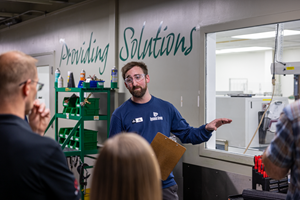Electronics Gradually Improving
Wood on Plastics
Pent-up demand U.S. consumers have will eventually make its way to electronics.
There is still a lot of pent-up demand for certain products consumed by Americans. When the housing bubble burst five years ago, an enormous amount of household wealth dropped with it. And the loss of jobs that occurred during the deep economic recession that followed was a severe jolt to consumers’ collective pocketbooks and psyche. This one-two punch put a big dent in household incomes and confidence levels. The result was a severe reduction in Americans’ propensity to consume many types of durable goods.
The effects of pent-up demand have had a favorable impact on the auto market and, to a lesser degree, on household appliances. But these effects have yet to show up in consumer electronics. This may soon be changing. When it does change it will be at a slow pace, but things will be moving in the right direction for processors that participate in this market.
The Consumer Electronics Association (CEA) conducts a monthly survey of households to measure confidence in the overall economy and their expectations about technology spending. After a sharp drop at the beginning of this year, the CEA Index of Consumer Technology Expectations trended higher in the second and third quarters. (This index is not seasonally adjusted, and it tends to be quite strong during the holidays.)
This recent increase in consumers’ expectations to purchase technology products is corroborated by the gain this year in U.S. production of computers and peripheral equipment. For the year to date, domestic output of these products is up 4% compared with the same period a year ago. That may not seem like such a big gain, but keep in mind that the once-dominant American computer industry has been in a tailspin ever since the recession.
So the good news is that after four straight years of steep declines, the output of the U.S. computer industry is poised to register a moderate increase this year. Our latest forecast calls for a 5% gain in production of computers and peripheral equipment in 2013. Prior to this year, this industry suffered an average annual decline in output of 14% every year since 2008.
The moderate gain this year will not be enough to put the industry anywhere near the level it held prior to the recession. There are two reasons why this industry is roughly two-thirds the size it was five years ago. The first is offshoring. Most of the products in this category were invented and developed in the U.S., and American households are still the biggest consumers of these products. But most of the manufacturing is now performed overseas. True, some manufacturing has been “reshored.” But this is not yet happening to a large degree, and probably never will.
The second problem with this industry is that there has been a significant shift in how Americans use technology. Americans no longer consume as many computers as they did a few years ago. Demand for televisions and home stereo equipment has also reached a plateau.
Mobile devices such as smart phones and tablets have replaced computers and other home-electronics devices for many needs. Data are increasingly being stored on large servers and then accessed via mobile devices. The need for desktop or laptop computers to store and process data is diminishing. There will be some replacement demand for computers in the business environment for a while, but the output from the U.S. computer industry will likely never return to the peak it hit in 2008.
WHAT THIS MEANS TO YOU
•Mobility is the dominant factor in consumer technology purchases. Molders will be tooling up to produce more types of portable, multi-purpose devices.
•Track the trends in residential construction: The demand for big-screen TVs, stereos, etc. will rise along with these trends.
•Monitor employment levels, as demand for personal computers will rise from current levels as companies start to hire more workers.
Related Content
Medical Molder, Moldmaker Embraces Continuous Improvement
True to the adjective in its name, Dynamic Group has been characterized by constant change, activity and progress over its nearly five decades as a medical molder and moldmaker.
Read MoreFoam-Core Multilayer Blow Molding: How It’s Done
Learn here how to take advantage of new lightweighting and recycle utilization opportunities in consumer packaging, thanks to a collaboration of leaders in microcellular foaming and multilayer head design.
Read MoreABC Technologies to Acquire Windsor Mold Group Technologies
The Tier One automotive supplier with compounding and blowmolding machine capabilities adds the 50-yr-old molder and moldmaker.
Read MoreIn Sustainable Packaging, the Word is ‘Monomaterial’
In both flexible and rigid packaging, the trend is to replace multimaterial laminates, coextrusions and “composites” with single-material structures, usually based on PE or PP. Nonpackaging applications are following suit.
Read MoreRead Next
Processor Turns to AI to Help Keep Machines Humming
At captive processor McConkey, a new generation of artificial intelligence models, highlighted by ChatGPT, is helping it wade through the shortage of skilled labor and keep its production lines churning out good parts.
Read MoreWhy (and What) You Need to Dry
Other than polyolefins, almost every other polymer exhibits some level of polarity and therefore can absorb a certain amount of moisture from the atmosphere. Here’s a look at some of these materials, and what needs to be done to dry them.
Read MorePeople 4.0 – How to Get Buy-In from Your Staff for Industry 4.0 Systems
Implementing a production monitoring system as the foundation of a ‘smart factory’ is about integrating people with new technology as much as it is about integrating machines and computers. Here are tips from a company that has gone through the process.
Read More












.png;maxWidth=300;quality=90)









